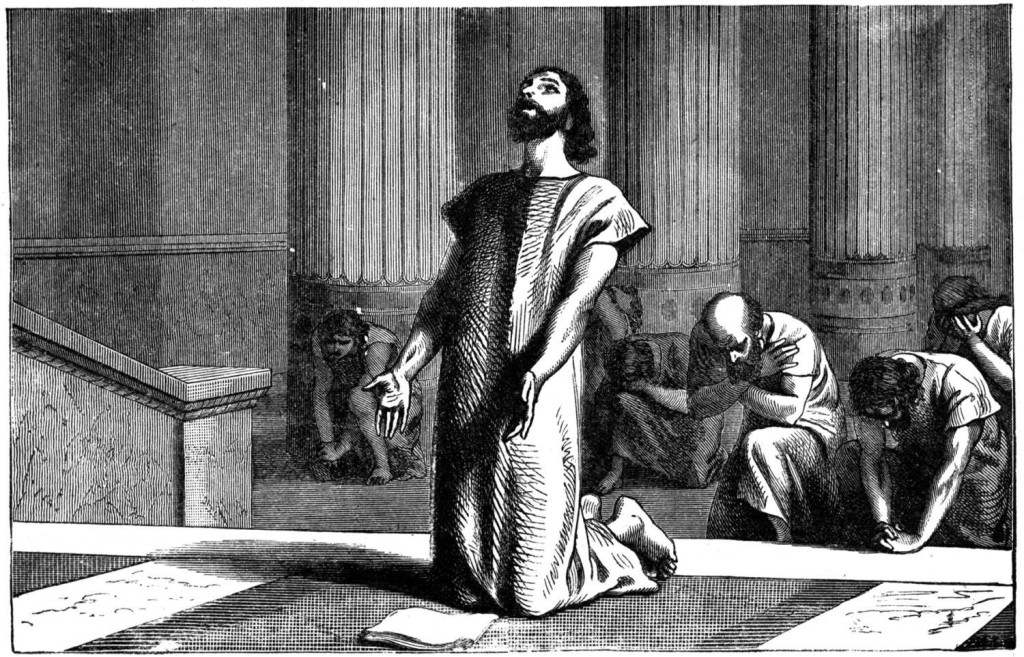Exodus 19:1, 11, In the third month…the third day.
Here we read that the Israelites arrived at Sinai in the third month. Jewish tradition teaches that YHVH most likely gave this order to the Israelites on the third day of the third month, and that this third day—the day YHVH gave the Ten Commandments—was on Shavuot.
Now let’s connect some dots or put some pieces of the puzzle together to form a prophetic picture of an amazing truth. Shavuot and the giving of the Ten Commandments was a day when YHVH, for the first time in recorded biblical history, sounded the heavenly shofar—known as the first trumpet. This relates back to the ram caught in the thicket by his horns. Abraham could see “the place” (Mount Moriah) afar off in three days (Gen 22:4), which related to Messiah’s first coming three millennia later. Likewise, the Israelites were to be ready “on the third day” to receive the Written Torah thundered from the lips of the pre-incarnate Yeshua the Messiah (Acts 7:38; 1 Cor 10:4) at Mount Sinai. But the “third day” reference here is also a prophecy analogous to Abraham’s “third day.” What is the connection? Abraham saw the death of the Redeemer on Mount Moriah and the Israelites were living out a prophecy that pointed to the same time when Messiah would come as the Living Torah culminating on the Feast of Shavuot. The “third day” reference for both Abraham and the Israelites had the same relevance, for both were living in the second century B.C. (i.e. before the birth of Yeshua, the Messiah) who was born near the beginning of the first century A.D.—or the third millennia, or third day prophetically, from both the time of Abraham and the Israelites.
Though a bit tangential to the subject of Shavuot, let’s look at another concept relating to the prophetic implications of the third day. As Yeshua, the Living Torah, came on the third day, so he will return on the third day after his first coming—or, in the third millennia after his first coming. That is, he came in the first millennium of our common era, and we have just passed into the third millennia of the same era and are now in the twenty-first century. According to biblical prophecy, Messiah will return in this third millennia, or third day:
Come, and let us return unto YHVH: for he has torn, and he will heal us; he has smitten, and he will bind us up. After two days will he revive us: in the third day he will raise us up, and we shall live in his sight. Then shall we know, if we follow on to know YHVH: his going forth is prepared as the morning; and he shall come unto us as the rain, as the latter and former rain unto the earth. (Hos 6:1–3)
This is a prophecy about the restoration of his people Israel in a spiritual marriage covenant to him (referred in Scripture as the “renewed covenant, see Jer 31:31,33; Heb 8:8–13). But it is also referring to the resurrection of the saints or, the bride of Messiah, who will participate in the marriage supper of the Lamb of YHVH. The saints are Israelites who are part of the Romans 11 olive tree whose root goes back to Abraham and to YHVH.
Yeshua makes further reference to the third day when he says,
…Behold, I cast out devils, and I do cures today and tomorrow, and the third day I shall be perfected. (Luke 13:32)
Yeshua was speaking of his ministry on earth at his first coming as well as his being resurrected on the third day. But, the “third day” is also a reference to his second coming in the third millennia or third day after his first coming. As he was “perfected” on the third day and raised from the dead, his saints will be “perfected” or resurrected at his second coming in the third millennia.
The Ten Commandments were given at Mount Sinai on the third day after two days preparation. That is, the children of Israel had two days to prepare and on the third day YHVH would give them his law from Mount Sinai. Similarly, Yeshua has had his people prepare themselves for 2000 years and in the third thousand-year period (or the seventh thousand year since creation—i.e. the Sabbath millennia) Messiah will return to resurrect his people after which the 1000-year sabbatical millennia will commence.
In reference to this, John records,
And the third day there was a marriage in Cana of Galilee… (John 2:1)
This is another prophetic statement referring to the marriage supper of Yeshua the Lamb of Elohim (Rev 19:7–9 cp. 2 Cor 11:2) to occur after the second coming of Yeshua Messiah in the third 1000-year period after his first coming.
Even after two days of preparation, ancient Israel was still not ready (spiritually) to receive the Torah from YHVH. On Shavuot, at Mount Sinai, YHVH entered into a marriage covenant with the children of Israel, but they were not ready to live up to the terms of that covenant. Those terms, simply stated, involved Israel being faithful and obedient only to YHVH, Israel’s spiritual marriage partner, and to his instructions in righteousness—the Torah. This Israel quickly demonstrated they were not willing to do, for they had hardly said “I do” to their marriage vows when they made and began worshipping the golden calf calling their act of spiritual adultery “a feast to YHVH” (Exod 32:5).
Between the time of the feasts of Shavuot and Yom Teruah when Moses received the second tablets of stone from YHVH containing the Ten Commandments, the children of Israel, the bride of YHVH, prepared herself not only to receive YHVH’s instructions the second time, and this time she was faithful to her marriage vows for approximately 38 years while she wandered in the wilderness after which she entered the Promised Land and “stayed the course” until after the death of Joshua.
Similarly, Messianic Israel of the first century a.d. (or “the Israel of Elohim,” Gal 6:16) received the Torah on the fleshly tablets of their hearts written by the finger of the Ruach HaKodesh on the day of Pentecost. But starting in about a.d. 70 with the destruction of the temple in Jerusalem and continuing up through the Second Jewish Revolt of a.d. 135 until the time of Emperor Constantine (in the fourth century), the second century bride of Messiah had, for the most part, abandoned YHVH’s Torah-commandments and had begun mixing the truth of Elohim with pagan practices, which was like the golden calf worship of old (e.g. Sunday worship, Christmas and Easter celebrations and many other pagan beliefs and traditions that exist in the Christo-pagan church to this day).
In our day, is not YHVH calling out a remnant of people who are leaving behind the traditions of golden calf worship, where the church has mixed the truth of YHVH’s Word with the pagan traditions of this world, and returning to the ancient blessed paths of YHVH’s Torah-instructions in righteousness (Jer 6:16, 19)? In fact, the Book of Revelation speaks of a group of end-time saints who will say “I do” to YHVH, and whose identifying mark is their faith in Yeshua the Messiah (i.e. the gospel message), and yet who faithfully keep YHVH’s Torah-commandments (Rev 12:17 and 14:12). Are these remnant redeemed believers not preparing themselves for the second coming of Messiah on the Yom Teruah when Yeshua, the Living Torah, will return to marry his spiritual bride—the saints, or sanctified ones, of YHVH (Rev 19:7–9)? As the children of Israel entered into the Promised Land under the leadership of Joshua, so YHVH’s spiritual bride will return to the spiritual Promised Land of Israel at the beginning of the Millennium under the leadership of Yeshua the Messiah (Heb 4:1–11).



